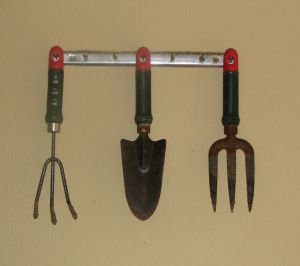Patch from Scratch July 09

Well the rain has certainly arrived which is of course great news for the garden, even if it does make drying the washing a tad challenging! Keep those beds well mulched over winter, the birds will come and scratch around a bit so it pays to check it every few weeks and top up when necessary. I’ve been cleaning up my garden tools, which is one of those tasks I always mean to get round to but it never quite gets to the top of the list. I must admit I’m a bit of a gadget collector when it comes to garden tools and have a number of favourites including a wooden paper pot maker, a dibber for planting leeks, a fancy soil thermometer that tells you what temp. the different veges need but my absolute favourite is a simple old wooden hand fork!
The ‘to do’ list for the garden is relatively short during July (to hubbys delight!) and more of my time is spent cooking rather than gardening. Still, there are always plans for spring to be made, a top up of compost, especially where you are planning to plant veges that don’t like fresh manure/ soil. It’s a great time to go to the beach and collect seaweed to make up a garden brew or to add to the compost heap too. Most of the insects have been driven away by the cold weather although there are always a few brave slugs around. I was at Auckland botanical gardens last week with Renée and Scarlett and I saw a huge caterpillar on one of the cabbages, I just couldn’t resist squishing him! If you have a free morning, it’s a wonderful place to go, they have some great vege and herb gardens.
How to grow Asparagus crowns
Plant asparagus crowns during July and August. You buy them in a bag with their roots surrounded by moist sawdust. Get them planted out before the sawdust and roots dry out. At this stage they are already 2 years old. Plant the crowns in a sunny weed free spot, in soil that drains well. Prepare the ground for planting by digging it over deeply. Break up all the hard bits of soil, add a bit of sand, some wood ash and manure. Mix it all in. Finally dig a trench 15cm deep and spaces the crowns 40cm apart and cover over the trench with the remaining soil. For the first year, don’t cut them, just let them grow, they will get feathery ferns. When these turn yellow (at the end of autumn), chop them down and burn them on top of the garden bed- the ash is then absorbed back into the soil, add a little compost and fertilizer at the stage too. In winter, cut plants at ground level. Asparagus are perennials and well looked after plants will last about 20 years, so all the tender care at the beginning will really pay off. In the 3rd spring you can harvest the spears for a 4-6 week period, up until then the plant is putting its energy into establishing good roots. In the 4th spring, harvest for 6-10 weeks, extending the harvest period each year.
Ants
The common ant is both a friend and foe in the garden. On the positive side, they feed on the larvae of pest insects but on the down side, they also carry aphids around the garden, spreading them far and wide. As a general rule, as long as you don’t get too many of them they are considered beneficial. We all know that ants don’t like the cold, which is why you are more likely to find them in your house during winter but they also love dry conditions. Finding them is a telltale sign that your soil needs more water. Even at this time of year, I have a few in my herb barrel which is quite sheltered on the deck. A quick fire way to get rid of them is to squirt them with lemon and water then give the soil a good drink. You can also leave lemon slices around (but not touching) the stem of susceptible plants. Plant mint, tansy and African marigolds to repel ants.
What to plant in July
- Asparagus
- Broccoli
- Cabbage
- Cauliflower
- Chinese Cabbage
- Garlic
- Peas
- Radish
- Silverbeet
- Perpetual Spinach
- Turnip
If you want to grow your own veges and could do with a helping hand to get the right start, then you may want to seek help. Patch from Scratch offers an all inclusive service building vege beds for beginner organic gardeners and busy people and helping you to get up and growing. We also offer Kits sets for DIY enthusiasts and a consultancy service for people who really want to do it all themselves but just need a bit of guidance. www.patchfromscratch.co.nz

